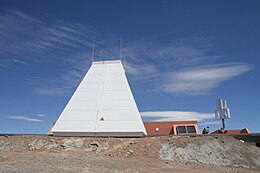Hexapod telescope
Engineers from Krupp Industrietechnik (later Vertex Antennentechnik) developed a concept for a completely new type of telescope design , the Hexapod Telescope (HPT) , in collaboration with astronomers from the Astronomical Institute (AIRUB) at the Ruhr University Bochum , and built this prototype in the 1990s.
The Zerodur optics come from Carl Zeiss, Jena. The main mirror has an aperture of 1500 mm. Instead of the classic two-axis assembly, the mirror is supported by six legs ( hexapods ) that can be adjusted in length . This arrangement with a hexapod mount allows the telescope to move in all six degrees of freedom of space. Due to the parallel structure, all six legs touch the support platform of the mirror, hexapods achieve a high structural rigidity. In addition to a high ratio of load bearing to dead weight, this also results in a very high level of precision in terms of positioning and repeatability. This concept was chosen because of these two advantages, although the orientation of the mirror is only required in two axes for use as a telescope and the control of hexapods is many times more complex. The HPT in Bochum was subjected to extensive tests under the project management of Rolf Chini. In 2006 it was moved to its new location, the Cerro Armazones in the Atacama Desert in Chile . The AIRUB is building its own observatory there with the Astronomical Institute of the Catholic University of Northern Chile in Antofagasta (Instituto de Astronomía de la Universidad Católica del Norte). A separate control building was built for the HPT.
For the HPT, the AIRUB is developing a spectrograph called BESO together with the State Observatory Heidelberg-Königstuhl . It is a copy of the FEROS spectrograph , which is operated very successfully by the European Southern Observatory (ESO).
literature
- Theodor Schmidt-Kaler : The Hexapod Telescope: A New Way to Very Large Telescopes . In: Progress in Telescope and Instrumentation Technologies , ESO Conference and Workshop Proceedings, ESO Conference on Progress in Telescope and Instrumentation Technologies, ESO, Garching, April 27-30, 1992, Garching: European Southern Observatory (ESO), 1992, edited by Marie- Helene Ulrich, p.117
- Rolf Chini: The Hexapod Telescope - A Never-ending Story . In: Reviews in Modern Astronomy 13: New Astrophysical Horizons . Edited by Reinhard E. Schielicke, Astronomical Society, 2000, p. 257
- I. Steiner, W. Seifert, Walter, O. Stahl, R. Lemke, R. Chini, I. Appenzeller: BESO: a high-resolution spectrograph for the Hexapod Telescope . In: Ground-based and Airborne Instrumentation for Astronomy . Edited by IS McLean, M. Iye. Proceedings of the SPIE, 2006, Volume 6269, p. 91
- T. Jürges: Design and implementation of a tracking correction for telescopes with more than two degrees of freedom of movement . Diploma thesis, University of Duisburg-Essen, Germany, 2004
Web links
- PI hexapods
- Hexapod telescope at the AIRUB
- Cerro Armazones Observatory (OCA)
- Design and implementation of a tracking correction for telescopes with more than two degrees of freedom of movement (diploma thesis, Thomas Jürges, University of Duisburg-Essen, Germany, 2004)
Coordinates: 24 ° 35 ′ 55.6 ″ S , 70 ° 12 ′ 5.9 ″ W.
